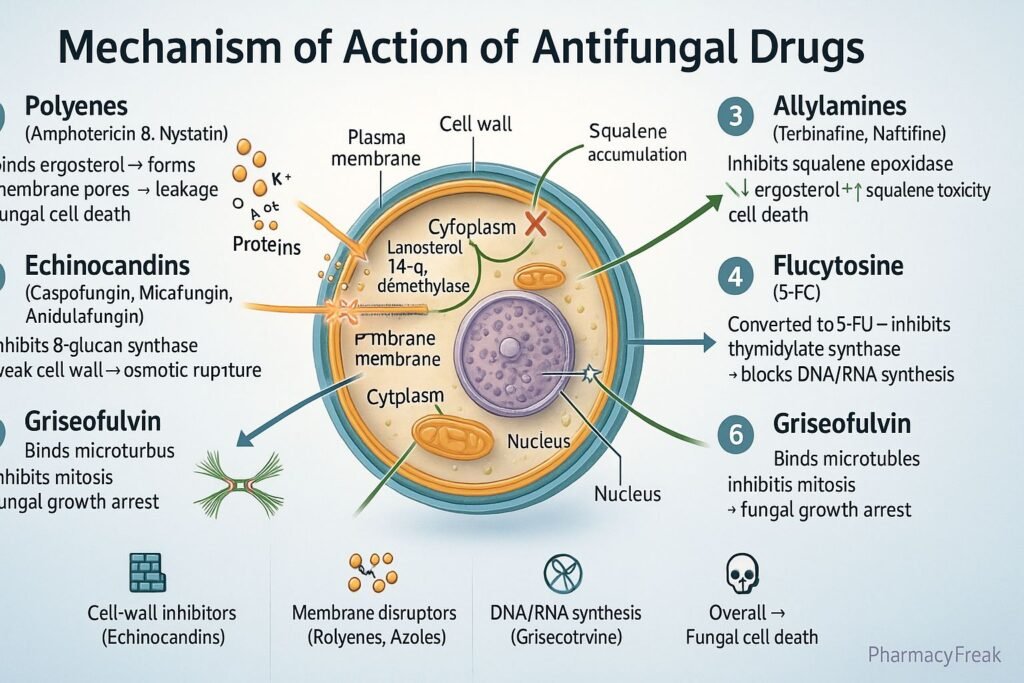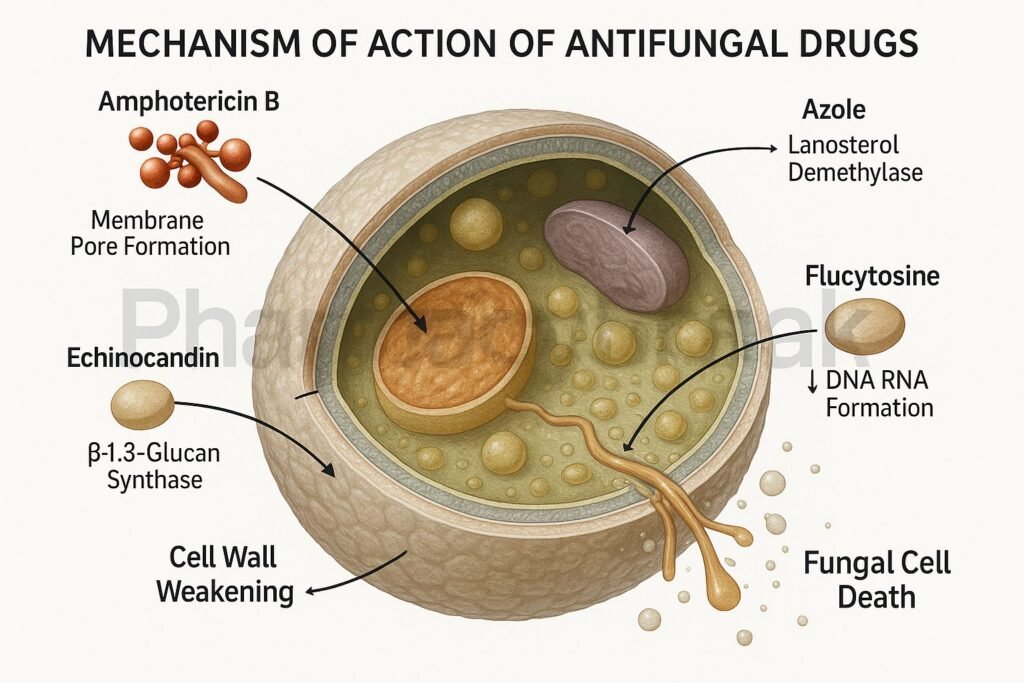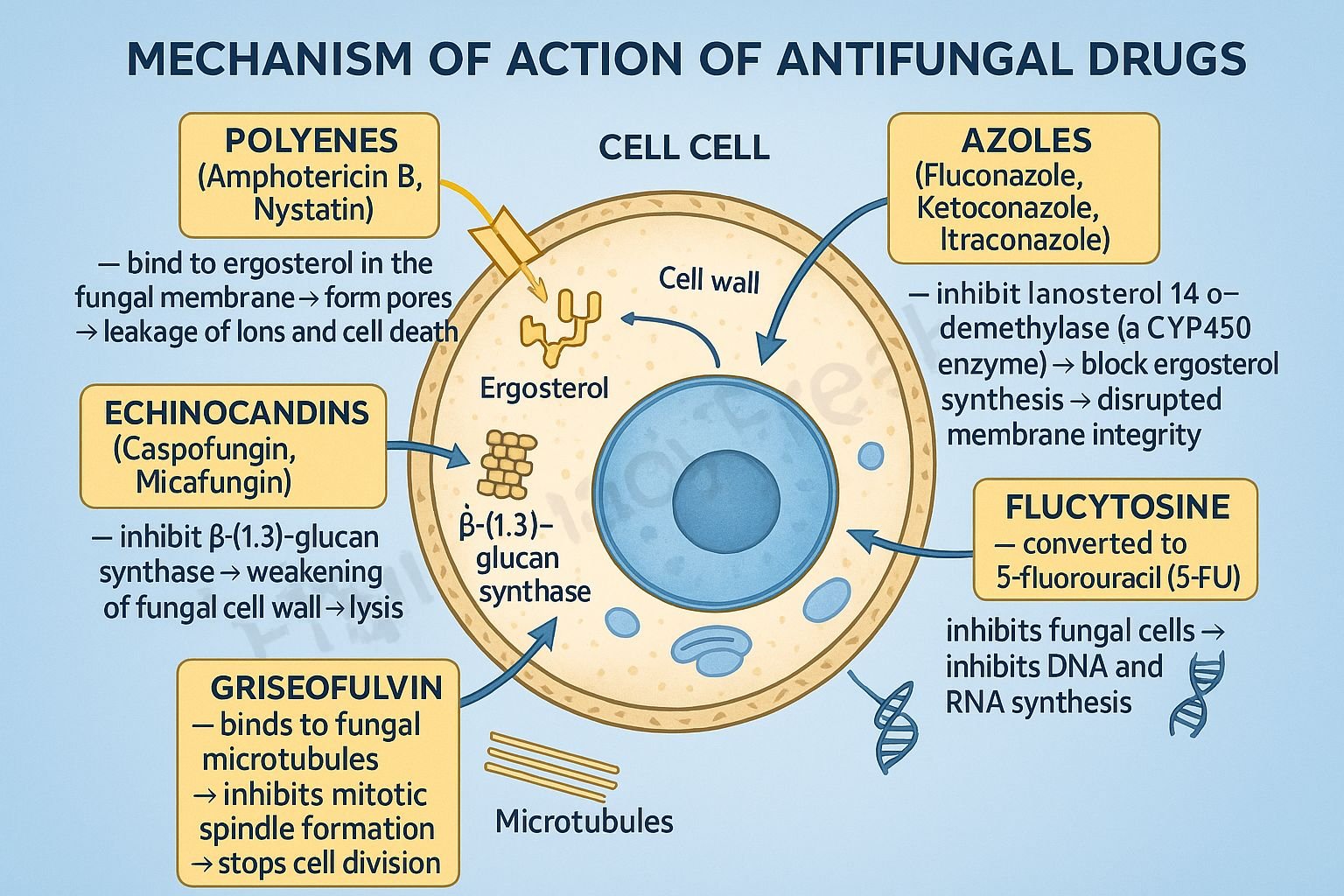Table of Contents


Introduction
Antifungal drugs are pharmacological agents that target fungal infections (mycoses) of the skin, mucosa, and internal organs. Mechanism of Action of Antifungal Drugs centers on disruption of ergosterol synthesis, cell membrane integrity, cell wall formation, or nucleic acid synthesis. Fungi are eukaryotic, so selective toxicity is achieved by exploiting pathways unique to fungal cells, such as ergosterol metabolism and β-glucan production, minimizing host cell damage.
Mechanism of Action (Step-wise)
1. Ergosterol Binding (Polyenes)
- Mechanism: Polyene antifungals bind directly to ergosterol, the main fungal membrane sterol.
- Effect: Formation of transmembrane pores → leakage of ions and macromolecules → cell death.
- Examples: Amphotericin B, Nystatin.
- Clinical note: Amphotericin B is systemic and fungicidal; Nystatin is topical for Candida infections.
2. Inhibition of Ergosterol Synthesis (Azoles and Allylamines)
a) Azoles
- Mechanism: Inhibit lanosterol 14-α-demethylase (cytochrome P450 enzyme) that converts lanosterol → ergosterol.
- Effect: Defective membrane structure → increased permeability → fungal death.
- Examples: Fluconazole, Itraconazole, Voriconazole, Ketoconazole, Posaconazole.
b) Allylamines
- Mechanism: Inhibit squalene epoxidase, an early enzyme in ergosterol synthesis.
- Effect: Accumulation of toxic squalene + ergosterol depletion → membrane disruption.
- Examples: Terbinafine, Naftifine.
3. Inhibition of Cell Wall Synthesis (Echinocandins)
- Mechanism: Block β-(1,3)-D-glucan synthase, an enzyme required for fungal cell wall integrity.
- Effect: Loss of structural strength → osmotic lysis.
- Examples: Caspofungin, Micafungin, Anidulafungin.
- Spectrum: Active against Candida and Aspergillus.
4. Inhibition of Nucleic Acid Synthesis (Flucytosine)
- Mechanism: Converted intracellularly by cytosine deaminase into 5-fluorouracil (5-FU), which blocks thymidylate synthase.
- Effect: Inhibits fungal DNA/RNA synthesis.
- Examples: Flucytosine (used with Amphotericin B for synergy).
5. Disruption of Mitotic Spindle (Griseofulvin)
- Mechanism: Binds fungal microtubules and inhibits mitosis.
- Effect: Arrest of metaphase → growth inhibition of dermatophytes.
- Examples: Griseofulvin.
Comparative Mechanism Table
| Class | Target | Mechanism | Examples |
|---|---|---|---|
| Polyenes | Cell membrane (ergosterol) | Binds ergosterol → pore formation | Amphotericin B, Nystatin |
| Azoles | Ergosterol synthesis | Inhibit lanosterol 14-α-demethylase | Fluconazole, Itraconazole |
| Allylamines | Ergosterol synthesis | Inhibit squalene epoxidase | Terbinafine |
| Echinocandins | Cell wall (β-glucan) | Inhibit β-(1,3)-D-glucan synthase | Caspofungin, Micafungin |
| Flucytosine | DNA/RNA synthesis | Converted to 5-FU → inhibits thymidylate synthase | Flucytosine |
| Griseofulvin | Microtubules | Inhibits spindle formation → mitosis arrest | Griseofulvin |
MCQs
1. Amphotericin B acts by:
a) Inhibiting ergosterol synthesis
b) Binding ergosterol and forming pores
c) Blocking β-glucan synthesis
d) Inhibiting microtubules
Answer: b) Binding ergosterol and forming pores
2. The enzyme inhibited by azoles is:
a) Squalene epoxidase
b) Lanosterol 14-α-demethylase
c) β-glucan synthase
d) Cytosine deaminase
Answer: b) Lanosterol 14-α-demethylase
3. Terbinafine inhibits:
a) DNA polymerase
b) Squalene epoxidase
c) Thymidylate synthase
d) Ergosterol binding
Answer: b) Squalene epoxidase
4. Echinocandins act by inhibiting:
a) β-(1,3)-D-glucan synthase
b) Ergosterol epoxidase
c) RNA polymerase
d) Protein synthase
Answer: a) β-(1,3)-D-glucan synthase
5. The antifungal converted to 5-FU inside fungal cells is:
a) Griseofulvin
b) Flucytosine
c) Itraconazole
d) Amphotericin B
Answer: b) Flucytosine
6. Griseofulvin acts on:
a) Cell wall
b) DNA synthesis
c) Microtubules
d) Ergosterol synthesis
Answer: c) Microtubules
7. Echinocandins are most effective against:
a) Candida and Aspergillus
b) Dermatophytes
c) Cryptococcus
d) Mucor
Answer: a) Candida and Aspergillus
8. The main sterol in fungal membranes is:
a) Cholesterol
b) Ergosterol
c) Lanosterol
d) Steroid alcohol
Answer: b) Ergosterol
9. Amphotericin B toxicity involves:
a) Hepatotoxicity
b) Nephrotoxicity
c) Cardiotoxicity
d) Pulmonary fibrosis
Answer: b) Nephrotoxicity
10. The antifungal safe for pregnancy is:
a) Amphotericin B
b) Fluconazole
c) Griseofulvin
d) Terbinafine
Answer: a) Amphotericin B
FAQs
Q1. What is the main difference between azoles and polyenes?
Azoles inhibit ergosterol synthesis, while polyenes bind ergosterol directly to disrupt the membrane.
Q2. Why are antifungal drugs less selective than antibiotics?
Fungi are eukaryotes like human cells, sharing similar metabolic pathways, limiting selective targets.
Q3. Which antifungal is first-line for systemic mycoses?
Amphotericin B is the gold-standard for severe systemic fungal infections.
Q4. Why is Flucytosine always used in combination?
Rapid resistance develops if used alone; it’s combined with Amphotericin B for synergistic action.
Q5. What is the target enzyme of Terbinafine?
Squalene epoxidase, which blocks ergosterol synthesis.
Q6. Which antifungal class inhibits cell wall synthesis?
Echinocandins, through β-glucan synthase inhibition.
References
- Harrison’s Principles of Internal Medicine
- Goodman & Gilman’s The Pharmacological Basis of Therapeutics
- Katzung’s Basic and Clinical Pharmacology
- Tripathi KD, Essentials of Medical Pharmacology

I am pursuing MBA in pharmaceutical management from NIPER Hyderabad with a strong academic record and proven success in national-level pharmacy entrance exams. I secured AIR 61 in NIPER 2024 (MS/M.Pharm) and AIR 27 in NIPER MBA, along with AIR 147 in GPAT 2024 and AIR 907 in GPAT 2023. I also achieved AIR 6 in AIIMS CRE-2025 for Drug Store Keeper and was selected as a Pharmacist (AIR 61) for ESIC. Additionally, I was the Runner-Up in Round 2 of the EY Case Study Competition.
At PharmacyFreak.com, I aim to guide future pharmacists through expert content, exam strategies, and insightful resources based on real experience and academic excellence.
Mail- harsh@pharmacyfreak.com

